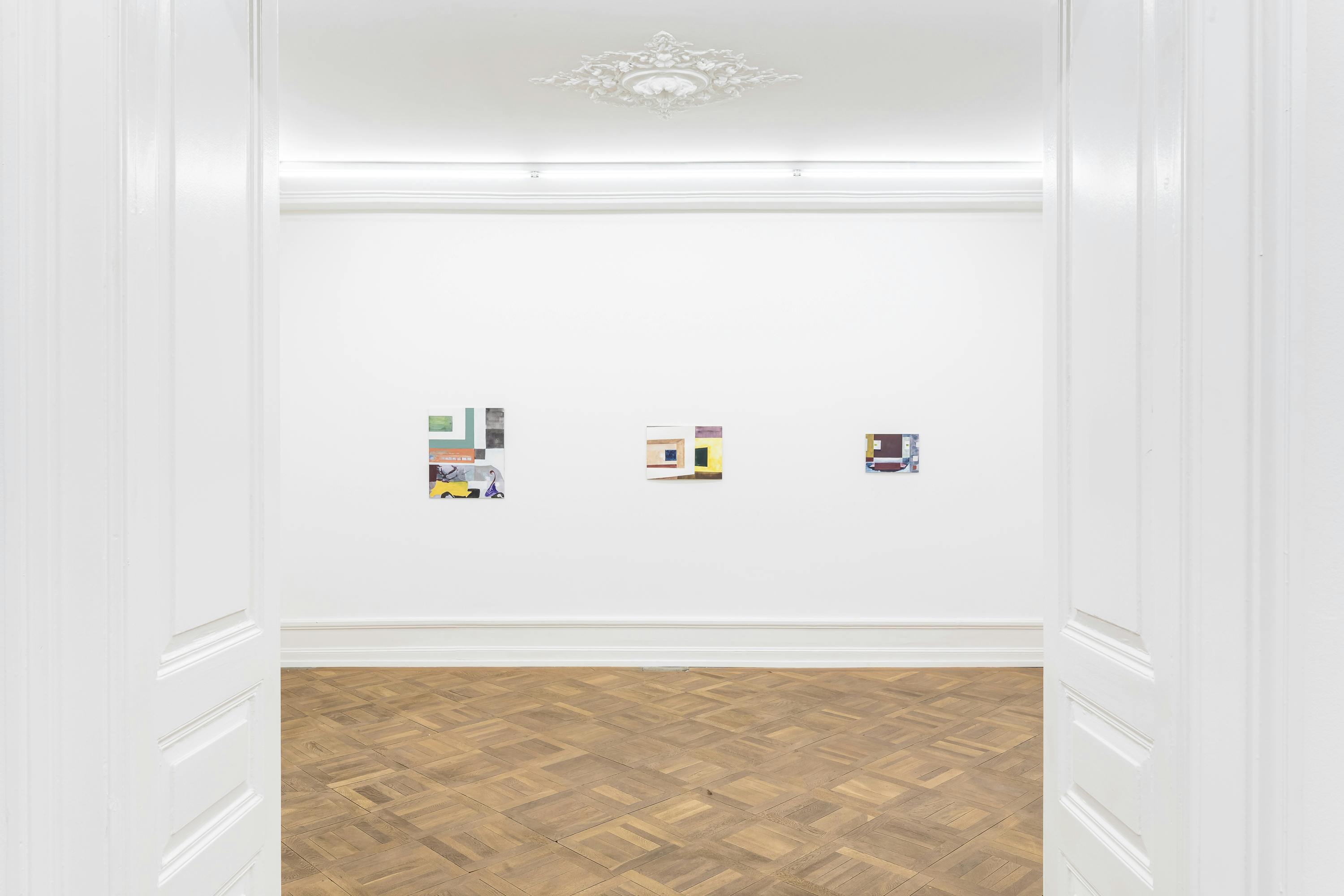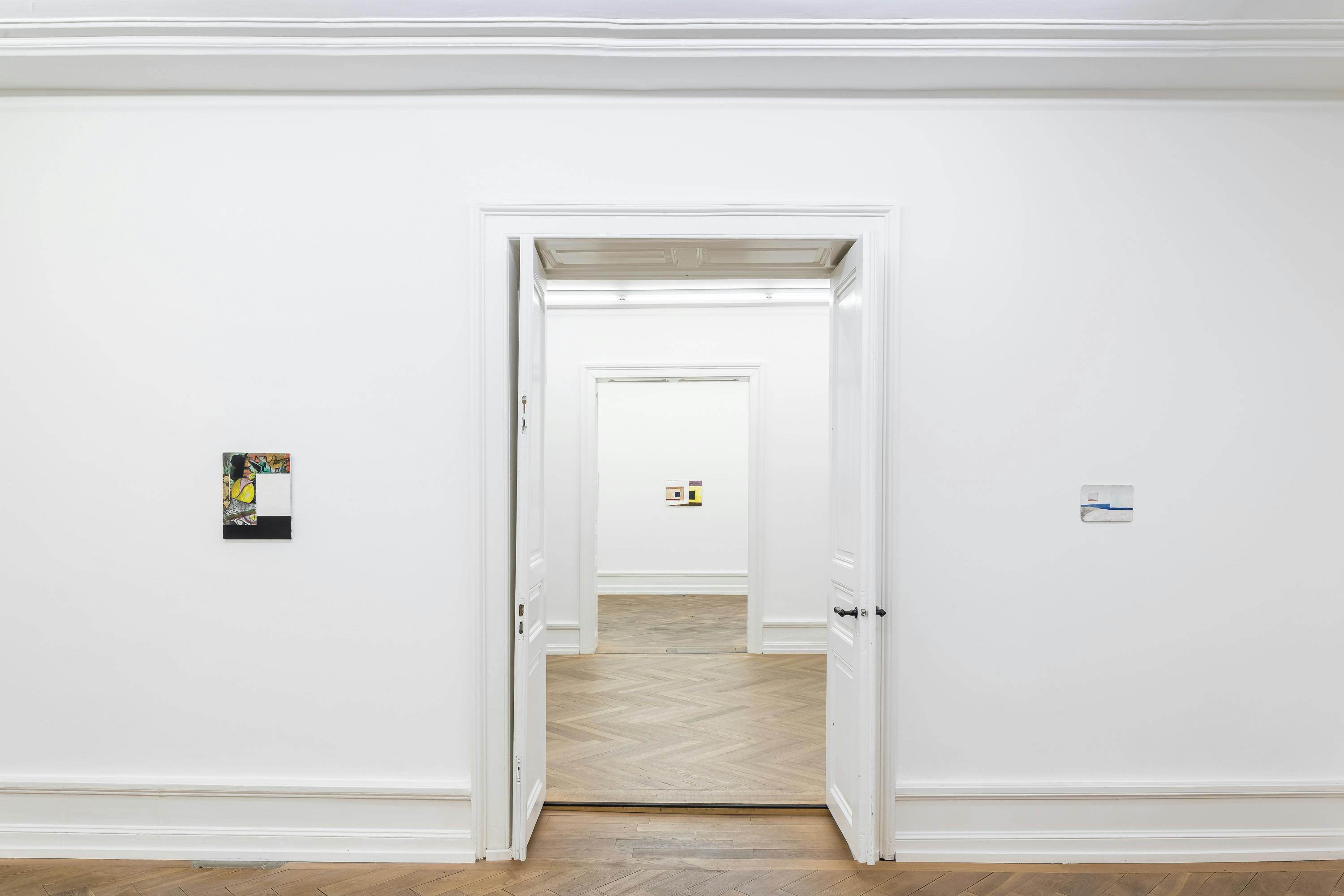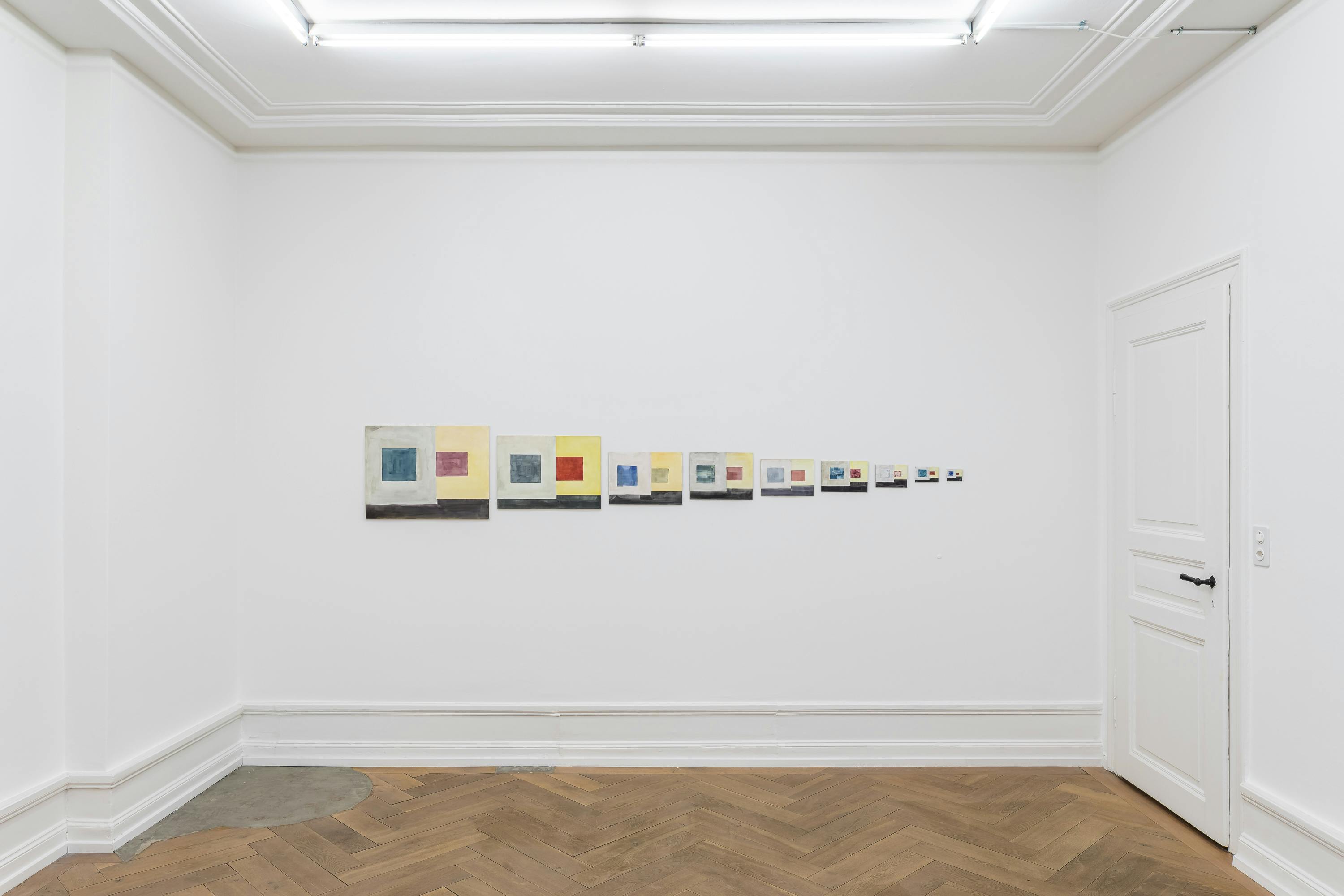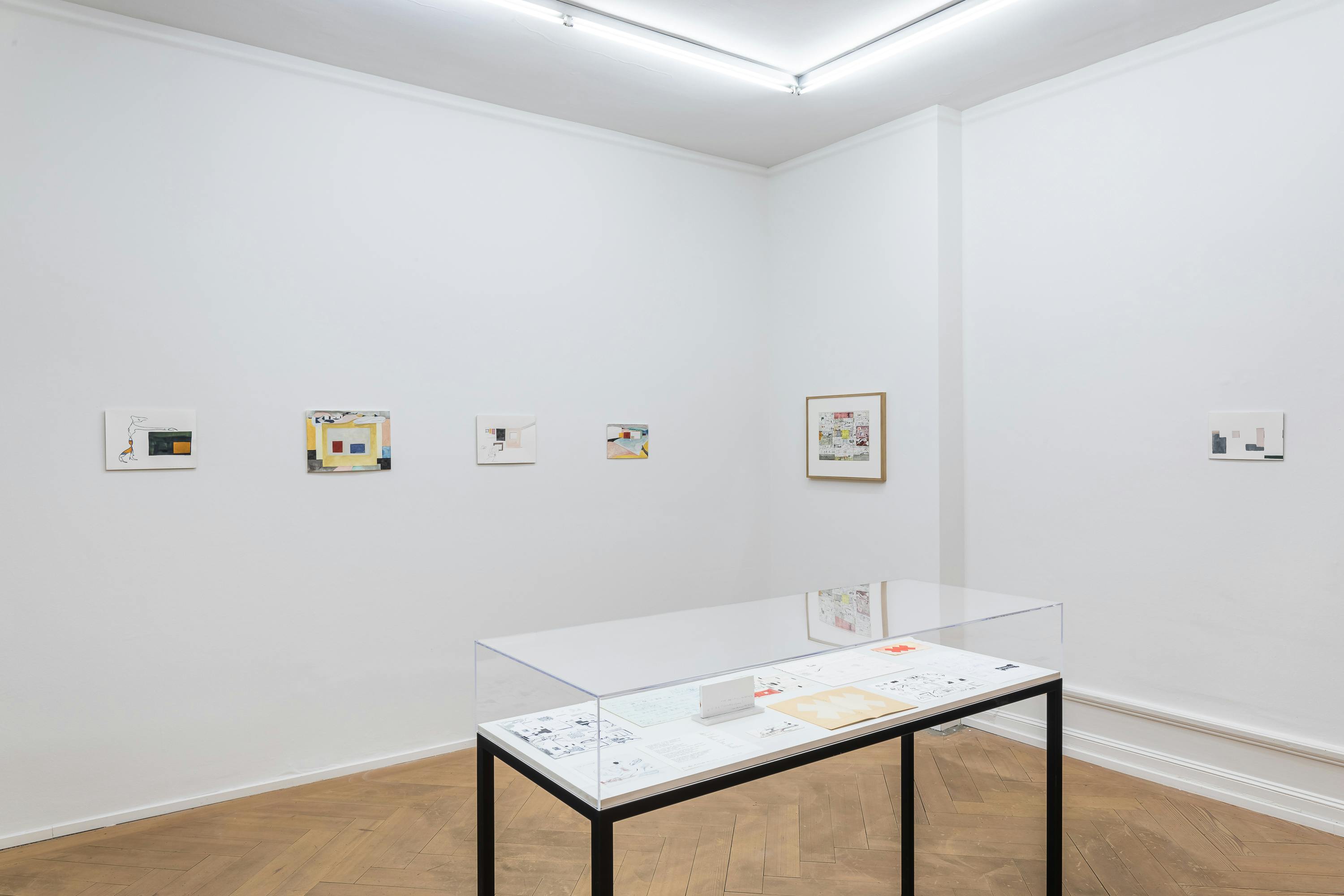Vernissage: Thursday, November 2, 2023, 6pm
Exhibition Duration: November 3, 2023 – January 6, 2024
Opening Hours: Tue-Fri 11am to 6:30pm, Sat 11am to 5pm
The title of his third exhibition at the Mai 36 Galerie, Ausstellung (vorbeiziehend), Ernst Caramelle has taken from a watercolor drawing from 2002. The subject on the front of the invitation card, in turn, is a section of a drawing with watercolor from 2018. This sheet is titled Ohne Titel R.G., which stands for «Rund Gang» and is written on the drawing; the chosen detail shows sketches with the presentation of images on display walls: as on display boards or on walls that divide an exhibition space in symmetrically staggered placement. So, the sheet Ausstellung (vorbeiziehend) now hangs on the wall in the exhibition of the same name in the gallery, as do Untitled R.G. and around thirty other works, the vast majority in watercolor and pencil on paper, only exceptionally with gesso primer and watercolor on wood. A large part of the mostly small-format and only exceptionally framed works can be subsumed under the concept of drawing, as Caramelle wrote decades ago, «very specific area and almost also the most important part of the work.»
Many works of the selection which was made with the artist for Ausstellung (vorbeiziehend) are and show images of exhibitions with pictures, in one watercolor a monk meditates in an exhibition room with pictures in front of a painting. Already ten years before Ausstellung (vorbeiziehend), a sketch sheet with the title Retrospective (vorbeiziehend) was created in 1992, which refers to a series of earlier works, first to the art-historically significant, legendary installation Video-Ping-Pong, which the then just 22-year-old artist was able to realize in 1974 at MIT, Cambridge. The sheet lies with ten others, some of them very small, in a vitrine that justifiably has the status of an exhibition within the exhibition. The serious play with the image within the image characterizes the entire œuvre of Ernst Caramelle; in front of this showcase, too, we might involuntarily feel reminded of the nested matryoshka or babushka dolls or think of the mise en abyme procedure. Another wonderful example of this: although there is no in situ wall painting in this exhibition, for which the artist has become known for since the mid-1980s, in the showcase there is a very small object, a pocket size wall painting.
In the showcase, the viewer is presented with a small-scale overview of Caramelle's work since the 1970s: in addition to Retrospective (vorbeiziehend) in sheets such as endlich alle works auf einen Schag from 1995 or complete works from 2009 or a schwall of bilder from 2017. Exhibited is also one of the light works in which the gifted watercolorist Caramelle leaves the color-work to the sun: The tiny sheet, dated 1985, is the earliest work in the exhibition and one of the first light works ever. Again and again we encounter the ‘two-dots-one-stroke face’, a faithful companion through Caramelle's work for four decades, and we realize that his ‘looking-at-me’ also works when the face for once has five eyes. The showcase-exhibition, however, may not only be regarded as the core of the large exhibition in which it stands; in this densely concentrated selection, the artist rather and beyond opens up for us a view into the center, onto the core of his work and his pictorial thinking and concept in general: as such references we may understand sheets such as a different language from 1991 or my personal baukasten from 1997.
Ernst Caramelle's work, which in a wide variety of media, is as disciplined as it is poetical, is firmly grounded in concept, including the permanent questioning of what we understand as art: In the lower part of the largest single painting in this exhibition view of the below he opens up to us a glimpse into what is going on in the informal amalgam beneath the picture; he titled a drawing from 2000 The Inside of the drawing. Even the young artist was a virtuos draftsman - his comic drawings from the early 1970s bear witness to this - and he is equally a confident painter of extremely sensuous watercolors. In both media, he benefits from experience gained during his initial training as a stained glass artist and his subsequent studies of industrial design. The entire exhibition focuses on small-format works, but there is at least one zig-zag intervention in the space, but, as mentioned, Ausstellung (vorbeiziehend) gets by without wall-sized in situ paintings. It is striking, however, what a monumental effect even really small watercolors with wall-painting-like color constellations can evoke: small pictures, very big, so to speak.
An important aspect in Caramelle's work concerns language and the very conscious, serious, also pseudo-scholarly ironic treatment of it. The design of the pieces of speech and writing also reveals the artist's closeness to Concrete Poetry, it permeates the use of language and is, like the whole work, also an attitude that meets the open spirit and the strolling practice of Fluxus with great sympathy. From the very beginning, the concept and complex of the work has also included the exhibition and the mediation of the work and the paintings, the conception and design of the exhibitions, including the printed matter and various ephemera that refer to them and appear in connection with them. The text sheet in the showcase 4 Wege möglicher Einstiege: in die Kunst, in die Rezeption von Kunst, bears witness to this approach.
The exhibition offers a sensually poetic tour through Caramelle's work of the past four decades. Exhibition (passing) is not a retrospective, there is no chronological sequence of works, no beginning and no end; however, the precise selection leads, strolling along detours, yet precisely into the center of this œuvre and into the thoughts behind it. Im Hirn is the name of a drawing from 2020, a horror vacui sheet of paper with countless sketches and notations. Ernst Caramelle would perhaps also describe the walk through the exhibition as a zigzag hike; one could also imagine the round of the path through the exhibition as a Möbius loop.
Ernst Caramelle (*1952 in Hall/Tyrol, Austria) lives in Frankfurt and New York. From 1994-2018 he held a professorship at the Staatliche Akademie der Bildenden Künste. The works of the artist, who was a participant of Documenta IX in 1992, are represented in renowned museum collections such as the Museum of Modern Art in New York and the mumok in Vienna. Among his most significant solo exhibitions are A Résumé, mumok, Vienna (2018), Illusion and Revelation, Bonnefantenmuseum, Maastrich (2016), Art Unlimited, Basel (2011), Anos 80: Uma Topologia, Museu de Arte Contemporânea de Serraves, Porto (2005).
Text: Beat Wismer, Curator







